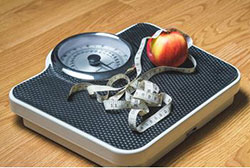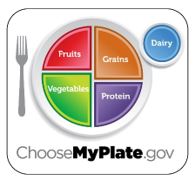by J. Clifford and J. Curley * (12/19)
Quick Facts…
- Healthy eating and regular physical activity are key to good health.
- Good health increases confidence, energy and productivity.
- Behavior change can be accomplished by identifying areas that need improvement, making step-by-step changes, and monitoring progress.
- The MyPlate method as the basis for a creating a healthy eating pattern that is enjoyable.
Weight management continues to be a major concern for many Americans.
- According to data from the National Health and Nutrition Examination Survey in 2015-2016, the prevalence of obesity was nearly 40% among adults.
- Over the last 20 years, a significant increasing trend in obesity was observed in both adults and youth.
- Those who are obese have medical costs that are roughly 42% higher than those who fall in the normal weight category.
- The weight loss market within the Unites States is now worth a record $72 billion.
- Only one in three American adults get enough physical activity each week to improve health and maintain a healthy weight.
Defining Overweight/Obese
Overweight and obese are labels for weight ranges created by the Centers for Disease Control and Prevention (CDC). A weight in one of these categories may increase the risk of certain diseases and health problems. The overweight weight category is described as somebody with a BMI between 25- 29.9. Obesity in adults is defined as a BMI of greater than or equal to 30.
Understanding BMI
BMI stands for body mass index and is calculated using height and weight. It is not a measurement of body fat, therefore it can’t capture body composition. Despite its limitations, it is a good starting point to evaluate health status. Other factors that can further evaluate overall health include activity level, dietary pattern, cholesterol levels, blood pressure, and blood sugar levels.
This CDC calculator provides BMI and the corresponding BMI weight status category for calculating BMI.
Is Weight Loss Right for Me?
Just because someone may be considered overweight does not mean that weight loss is mandatory. A healthy weight is individual to that person. However, generally, weight loss is suggested for individuals with a BMI greater than or equal to 30 or individuals with a BMI in the 25 to 29 range who also have two other weight-related risk factors for illness. Weight-related risk factors include hypertension, high total cholesterol and a family history of obesity-related disease. Overweight individuals with high waist circumferences also are encouraged to lose weight.

Where fat is distributed in the body (determined by your waist circumference) plays an important role in determining whether weight loss may be recommended. Pear-shaped bodies have more fat in the hips and thighs, while apple-shaped bodies store it in the upper body and abdomen. Research shows that people with apple-shaped bodies are more at risk for health problems. A waist circumference greater than 35 inches for women and 40 inches for men are considered to be at a greater risk.
Benefits of Weight Loss
Weight loss can boost confidence, energy, and productivity, which can lead to increased self- esteem, satisfaction, and happiness. If you and your doctor believe your weight is an issue, even small, sustained weight loss of just 3-5% of baseline weight can produce clinically relevant health improvements, like reductions in triglycerides, blood glucose, and risk of developing type 2 diabetes. Furthermore, larger, healthy weight reduction of 5-10% of baseline weight that is maintained can result in decreased blood pressure and cholesterol and decrease the need for medication to control cardiovascular disease and type 2 diabetes.
A Healthy and Sustainable Weight Loss Plan
Healthy weight loss is around 1-2 pounds per week. The most successful and sustainable weight loss plans combine diet, exercise, and behavioral change. The first step is to identify behaviors that may be contributing to weight gain. These will be unique to everybody and could include behaviors such as consuming large portions, eating for emotional reasons, eating too many meals away from the home, or skipping meals. The next step is to pick one behavior at a time and begin to make changes. It is helpful to keep track of progress, which could be done by journaling food intake/ physical activity, conducting weekly weigh-ins, and/or taking body measurements. Improving eating habits and increasing physical activity even slightly can help people maintain a healthy weight. If you need help devising a plan and determining what behavior changes are appropriate for you, ask your doctor for a referral to a register dietitian nutritionist.
With all the focus on weight in our society, it is not surprising that the weight loss market is at an all-time high. Be wary of fad diets or phony weight loss products. The simple truth is, if a diet or product sounds too good to be true, it probably is. There are no foods or pills that will magically burn fat. Some ingredients in supplements and herbal products may even be dangerous to certain people or have not undergone proper testing.
Another weight loss technique many individuals turn to is extreme calorie restriction. This behavior can be dangerous to your health and is simply not sustainable in the long run. The body requires energy to carry out normal biological functions like digestion, breathing, and pumping blood. Eating too few calories, which for most can be described as less than 1200 calories for women and less than 1500 calories for men can put your health at risk in many ways. First off, one will not be able to meet his or her nutrient needs, which can put the body at risk for vitamin/mineral deficiencies or weaken the immune system. Second, the body thinks it is starving and starts breaking down muscle for energy and slowing down metabolism to conserve energy. Finally, the brain won’t be able to function properly.
A Healthy Lifestyle
In order to maintain a healthy weight or achieve sustained weight loss, adopting a healthy lifestyle is necessary. A healthy lifestyle is described as incorporating behaviors that aim to reduce excess energy intake, enhance diet quality, and increase physical activity. There are varieties of different approaches one can take to effectively reduce energy intake. Individuals should find what works for them, while also considering their health and nutrient status. The easiest way to ensure obtaining proper nutrients is to eat a variety of foods from all the food groups.
A Healthy Eating Pattern
This does not mean dieting, but rather managing lifestyle with the foods that one eats. This also does not mean giving up the great-tasting foods that someone loves. It does mean developing a sensible, balanced eating plan and committing to making behavior changes. It is important to remember that there is no such thing as a one- size fits all approach to weight management.

MyPlate (www.choosemyplate.gov) is a visual and tool for building a healthy diet. MyPlate emphasizes the importance of the five food groups to get the nutrients you need. Fruits and vegetables from a variety of sources should make up half the plate. Half of all grains consumed should be in the form of whole grains due to their added fiber and vitamin/mineral content. Low-fat or fat-free milk and yogurt are encouraged over full fat. People should aim to consume protein from a variety of sources that include both animal and plant- based proteins. The overall goal is to choose an eating pattern low in saturated fat, sodium, and added sugars.
Cooking and preparing meals at home allows more control over what and how much someone eats. Despite this, Americans eat about 24% of their meals away from home. This could be for a variety reasons, whether it be for social celebrations, for convenience, or due to a lack of cooking skills. Food prepared away from home is meant to look, smell, and taste great meaning nutrition isn’t necessarily the priority. Additionally, dishes are commonly served in large portion sizes. Therefore, it becomes increasingly important to understand how to eat healthy away from the home.
Here are some tips for eating healthy away from home.
- Have a plan- If you know ahead of time that you are going out have lighter meals during the day.
- Visualize MyPlate and be deliberate when ordering to create a balanced meal. Fill your plate with vegetables, fruit, and whole grains.
- Watch for wording and ask questions. Look for words such as “grilled”, “broiled”, “steamed”, or “baked,” meaning the food is cooked with less fat. Ask for sauces and dressings on the side or ask to make substitutions.
- Ask for a to-go box. Eat half in the restaurant and take the rest home to enjoy the next day.
- To control portion sizes, build a meal from the appetizer or side dish section of the menu or share a main dish.
- Consider your drink choice. Choose beverages without added sugar.
Physical Activity

Regular physical activity is important to good health. Combined with healthy eating, physical activity is a great way to regulate weight because it burns calories and can help individuals feel more energized. Physical activity may reduce body fat percentage, which may lower the risk for heart disease even in those who are overweight. Physical activity helps improve stress levels, too. Unfortunately, less than 5% of adults participate in 30 minutes of physical activity each day.
Any activity that gets someone up and moving can contribute to a healthier lifestyle. If someone chooses an activity he or she enjoys, it is more likely that he or she will sustain that activity. The recommendation is 30 minutes of moderate- to vigorous-intensity activity most days of the week for prevention of chronic disease. Examples of moderate-intensity physical activities are listed. Increasing duration of activity to 45-60 minutes most days is recommended for weight-loss maintenance. Starting slowly and gradually building up to 45 or 60 minutes of physical activity may be effective, or doing activity in multiple 10-15 minute segments throughout the day may be a better choice for some.
| Below are some examples of moderate-intensity physical activities |
|
Independent of time spent performing intentional physical activity, sedentary behavior has been associated with an increased risk of obesity. Reducing leisure screen time can help with weight management. It can help some people to track the amount of time spent per day watching TV or using a computer/tablet/phone to help identify where they can make improvements. Using a pedometer or fitness tracker to track steps taken each day can help monitor progress.
Easy ways to add activity throughout the day.
- Take a brisk 10-minute walk or walk the stairs up and down on your lunch break. You’ll feel good and have more energy, too!
- Hop off the bus a few blocks early or park your car further away and walk briskly the rest of the way.
- Keep active around the house: sweep the garage, scrub the floors, vacuum the rugs or trim the shrubs. It all helps you get fit, and the house will look great, too!
- Get energized! Take a brisk 10-minute walk in the morning, at lunch and after dinner to total 30 minutes a day.
Enlisting Support
Everyone can adopt a healthy lifestyle. Enlisting support from friends and family can help hold people accountable for changes they want to make. Long-term success is more likely with supportive family and friends. They can encourage healthy eating and regular exercise.
Behavior Change
The key to managing good health and maintaining a healthy weight throughout life begins with a positive attitude and realistic goals. Challenging one’s self to think beyond external factors, like physical appearance, may be motivating. Drawing upon internal motivators like a desire to have more energy, improve self- esteem, or live longer to be there for loved ones can help motivate people to make behavior changes that are lasting. Setting small, achievable changes over time is more attainable for most people, and as progress happens, more changes can be made.
Set “SMART” Goals
Weight loss may be a goal of yours, but recognize that there are other measures of health and/or ways to measure success. Goals can be related to healthy eating, increased activity, or improving markers of health, such as cholesterol or blood pressure.
Goal setting is a useful strategy when trying to make lifestyle changes. Goals should be Specific, Measurable, Attainable, Relevant, and Time- bound to be effective. These are “SMART” goals.
Examples of SMART goals include:
- “I will plan to prepare most of my meals at home and allow myself two meals out per week.”
- “Today, I will replace two out of three of the sugar sweetened beverages I drink with unsweetened sparkling water.”
- “I will do 30 minutes of physical activity before dinner on three of the five work days each week.”
- “For three days, I will track my food intake in a journal or smartphone app.”
- “Starting next week, I will participate in Meatless Monday, and eat no meat on Mondays.”
Moderation and Portion Control
With a healthy lifestyle, all foods are allowed. Yet, the foods to get most of include fruits, vegetables, whole grains, lean proteins, and low-fat dairy, while reserving foods with saturate fat, added sugars, and sodium for occasional treats. Moderation and balance are key to getting the nutrients the body needs, while not consuming excess calories beyond the body’s requirements. Everyone’s body and needs will vary slightly.
Strategies to achieve moderation and balance:
- Plan meals ahead of time. By planning, it can be easier to make sure you are including variety and balance with each meal or throughout the week.
- Eat at the table, away from the TV, work, or other distractions.
- Eat mindfully. This means using all of your senses when you eat. Look at your food and notice colors and textures, smell the food and aromas, notice the texture in your mouth, finally, taste and notice complex flavors. This process of eating requires more time so you will feel full longer and helps you to appreciate your food.
- Slow down. It takes 20 minutes for your brain to send the signal that you’ve had enough to eat. Take small bites and chew your food well. Aim to eat until you are 70-80 percent full and stop.
- Serve your snacks on a plate or in a bowl to control the amount you eat, rather than eating straight out of the container.
- Allow yourself to enjoy a little bit of what you love to eat, guilt-free, in order to establish a healthy relationship with food. Deprivation or restriction can lead to negative emotions and behaviors around food, which can be harmful in the development of a healthy lifestyle in the long-term.
Good health and weight management include a life-long commitment to a healthy lifestyle. The best way to achieve a healthy weight is to eat a healthy diet that includes all food groups, and has plenty of whole grains, fruits and vegetables. Incorporating at least 30 minutes of physical activity each day can help individuals achieve or maintain good health.
References
Academy of Nutrition and Dietetics [US] Fact Sheets. (2019), www.eatright.org/health/..
Position of the Academy of Nutrition and Dietetics: Interventions for the Treatment of Overweight and Obesity in Adults. (2016). Journal of the Academy of Nutrition and Dietetics, 116, 1.
Hales CM, et al. (2017). Prevalence of obesity among adults and youth: United States, 2015–2016. NCHS data brief, no 288. Hyattsville, MD: National Center for Health Statistics.
Facts and statistics by the U.S. Department of Health and Human Services (2018).
Colorado State University, U.S. Department of Agriculture and Colorado counties cooperating. Extension programs are available to all without discrimination. No endorsement of products mentioned is intended nor is criticism implied of products not mentioned.
*J. Clifford, Extension Nutrition Specialist, Department of Food Science Human Nutrition; J. Curley, Graduate Student, Department of Food Science Human Nutrition. Original authors: J. Anderson and L. Young. 12/10. Revised 12/19.
Colorado State University, U.S. Department of Agriculture and Colorado counties cooperating. Extension programs are available to all without discrimination. No endorsement of products mentioned is intended nor is criticism implied of products not mentioned.
Go to top of this page.





